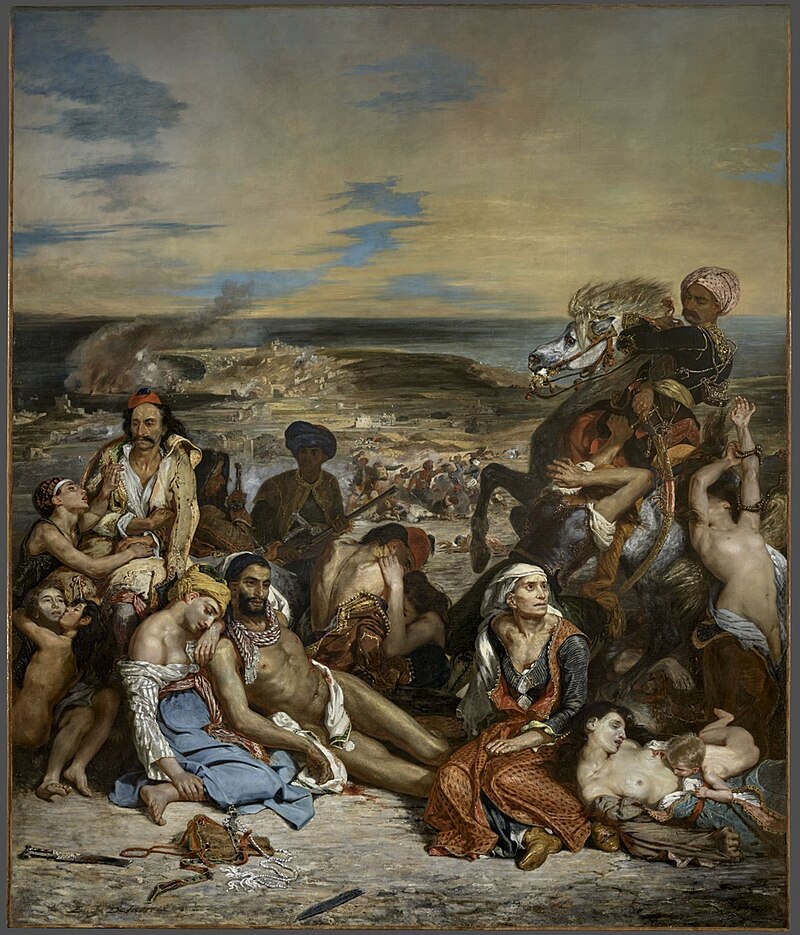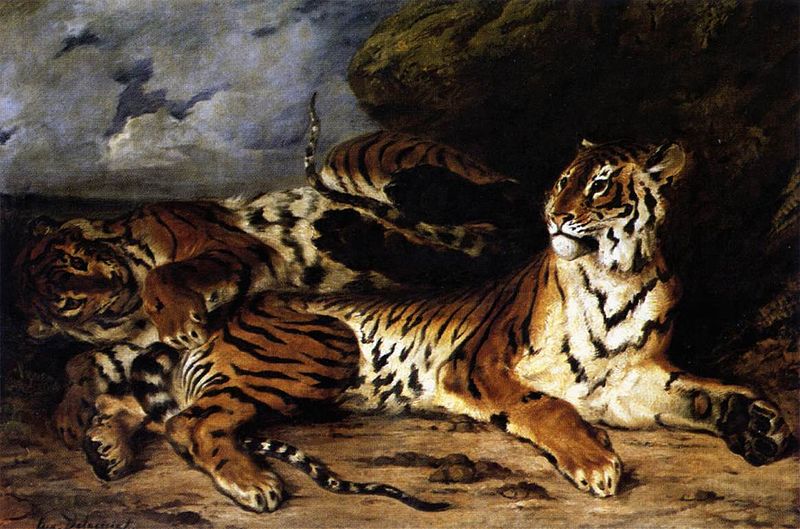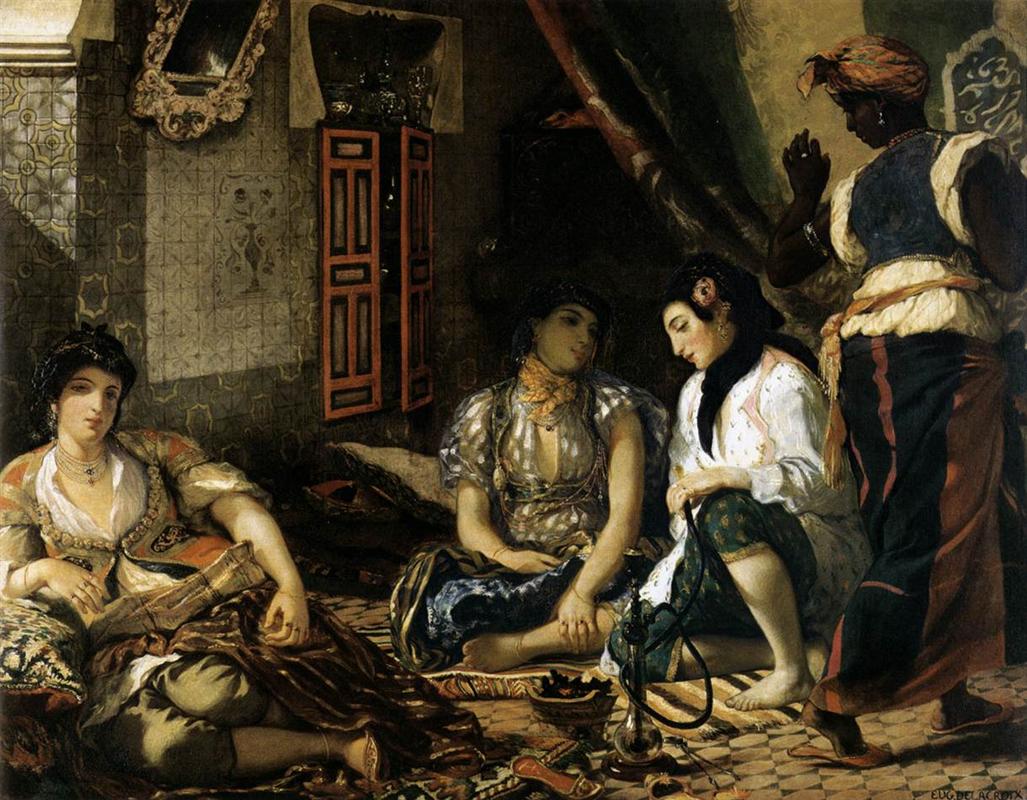Musée du Louvre, Paris
March 29, 2018 to July 23, 2018
This exhibition is organized by the Musée du Louvre, Paris, and the Metropolitan Museum of Art, New York.
http://presse.louvre.fr/delacroix-1798-1863-2-en/
Eugène Delacroix was one of the giants of French painting, but his last full retrospective exhibition in Paris dates back to 1963, the centenary year of his death. In collaboration with the Metropolitan Museum of Art in New York, the Louvre is holding a historic exhibition featuring some 180 works—mostly paintings—as a tribute to his entire career. From the young artist’s big hits at the Salons of the 1820s to his final, lesser-known, and mysterious religious paintings and landscapes, the exhibition will showcase the tension that characterizes the art of Delacroix, who strove for individuality while aspiring to follow in the footsteps of the Flemish and Venetian masters of the 16th and 17th centuries. It will aim to answer the questions raised by Delacroix’s long, prolific, and multifaceted career while introducing visitors to an engaging character: a virtuoso writer, painter, and illustrator who was curious, critical, and cultivated, infatuated with fame and devoted to his work.
The exhibition will bring together masterpieces by Delacroix from museums in France (Lille, Bordeaux, Nancy, Montpellier, etc.) and exceptional international loans, particularly from the United States, Great Britain, Germany, Canada, Belgium, and Hungary.
The exhibition will bring together masterpieces by Delacroix from museums in France (Lille, Bordeaux, Nancy, Montpellier, etc.) and exceptional international loans, particularly from the United States, Great Britain, Germany, Canada, Belgium, and Hungary.
Much remains to be learnt about Delacroix’s career. It spanned a little over forty years, from 1821 to 1863, but most of his best known paintings were produced during the first decade. The output from the next three quarters of his career is difficult to define, as it cannot be confined to a single artistic movement. Although Delacroix is often hailed as a forerunner of modern colorists, his career does not always fit a formalist interpretation of 19th-century art.
The exhibition is organized in three sections, presenting the three major periods in Delacroix’s long career and highlighting the motivations that may have inspired and guided his painting. The first section — focusing on the conquest and triumph of the first decade — studies the artist’s break with neoclassicism and his renewed interest in the expressive and narrative possibilities of paint.
The second part explores the ways in which his large public murals (his main activity from 1835 to 1855) impacted on his easel painting, with its visible tension between the monumental and the decorative.
Finally, the third section shows how his later years were seemingly dominated by a keen interest in landscape painting, tempered by an attempt to extract the essence from his visual memories.
The second part explores the ways in which his large public murals (his main activity from 1835 to 1855) impacted on his easel painting, with its visible tension between the monumental and the decorative.
Finally, the third section shows how his later years were seemingly dominated by a keen interest in landscape painting, tempered by an attempt to extract the essence from his visual memories.
These keys to interpretation allow for a new classification that goes beyond a mere grouping by genre and transcends the classical–Romantic divide, indicating instead that Delacroix’s painting resonated with the great artistic movements of his day: Romanticism of course, but also Realism, eclecticism, and various forms of Historicism.
Exhibition curators: Sébastien Allard, Director of the Department of Paintings, Musée du Louvre; Côme Fabre, Department of Paintings, Musée du Louvre; Asher Miller, Department of European Paintings, The Metropolitan Museum of Art.

Eugène Delacroix, July 28, 1830: Liberty Leading the People. 1830. 1831 Salon. Oil on canvas. 260 x 325 cm. Musée du Louvre, Paris © RMN-Grand Palais (musée du Louvre) / Michel Urtado

Eugène Delacroix, The Barque of Dante. 1822. 1822 Salon. Oil on canvas. 189 x 246 cm. Musée du Louvre, Paris © RMN-Grand Palais (musée du Louvre) / Franck Raux

Eugène Delacroix, Woman with a Parrot. Between 1826 and 1829. Oil on canvas. 24.5 x 32.5 cm.Musée des Beaux-Arts, Lyon © Lyon MBA / Photo Alain Basset.
Eugène Delacroix, Self-Portrait with Green Vest.Circa 1837. Oil on canvas.
65 x 54 cm. Musée du Louvre,Paris © RMN-Grand Palais (musée du Louvre) / Michel Urtado
Eugène Delacroix, Portrait of Baron Louis-Auguste Schwiter. 1826. Rejected at the 1827 Salon. Oil on canvas. 217 x 143 cm. National Gallery, London © The National Gallery, Londres

Eugène Delacroix, Massacres at Chios. 1824. 1824 Salon. Oil on canvas. 419 × 354 cm. Musée du Louvre, Paris © RMN-Grand Palais (musée du Louvre) / Stéphane Maréchalle / Adrien Didierjean
Eugène Delacroix, The Death of Sardanapalus. 1827. 1827-1828 Salon. Oil on canvas. 392 x 496 cm. Musée du Louvre, Paris © Musée du Louvre, dist. RMN - Grand Palais / Angèle Dequier
Eugène Delacroix, Macbeth and the Witches (first state, before the letter and signature).1825. Lithograph. 33 x 25.7 cm. Städelsche Kunstinstitut und Städtische Galerie, Frankfurt © Städel Museum - U. Edelmann - ARTOTHEK
Eugène Delacroix, Greece on the Ruins of Missolonghi. 1826. Oil on canvas. 209 x 147 cm. Musée des Beaux-Arts, Bordeaux © Musée des Beaux-Arts, ville de Bordeaux. Cliché L . Gauthier, F . Deval
Eugène Delacroix, Still Life with a Lobster. 1827 Salon. Oil on canvas. 80 x 106.5 cm. Musée du Louvre, Paris © RMN-Grand Palais (musée du Louvre) / Stéphane Maréchalle

Eugène Delacroix, Young Tiger Playing with Its Mother. 1830. 1831 Salon. Oil on canvas. 130 x 195 cm. Musée du Louvre, Paris © RMN-Grand Palais (musée du Louvre) / Franck Raux
Eugène Delacroix, Young Orphan Girl in the Cemetery. 1824.1824 Salon. Oil on canvas. 65.5 x 54.3 cm. Musée du Louvre, Paris © RMN-Grand Palais (musée du Louvre) / Mathieu Rabeau
Eugène Delacroix, The Death of Charles the Bold at the Battle of Nancy. 1831. 1834 Salon. Oil on canvas. 237 x 356 cm. Musée des Beaux-Arts, Nancy © P. Mignot
Eugène Delacroix, Apollo Victorious over Python (sketch for the ceiling of the Galerie d’Apollon). 1850. Oil on canvas. 137 x 102 cm. Royal Museums of Fine Arts of Belgium, Brussels © MRBAB, Bruxelles /photo : J. Geleyns - Art Photography

Eugène Delacroix, Women of Algiers in Their Apartment. 1833-1834. 1834 Salon. Oil on canvas.180 x 229 cm. Musée du Louvre,Paris © RMN-Grand Palais (musée du Louvre) / Franck Raux
Eugène Delacroix, Medea About to Murder Her Children.1838. 1838 Salon. Oil on canvas. 206 x 165 cm. Palais des Beaux-Arts, Lille © RMN-Grand Palais / Stéphane Maréchalle
Eugène Delacroix, The Lamentation (Christ at the Tomb).1847. 1848 Salon. Oil on canvas. 161.3 x 130.5 cm. Museum of Fine Arts, Boston. Photograph © 2018 Museum of Fine Arts, Boston
Eugène Delacroix, Basket of Flowers. 1848-1849. 1849 Salon. Oil on canvas. 107 x 142 cm. The Metropolitan Museum of Art, New York Image © The Metropolitan Museum of Art
Eugène Delacroix, Lion Hunt. 1854-1855. Exposition Universelle (1855). Oil on canvas. 173 x 361 cm. Musée des Beaux-Arts,Bordeaux © Musée des Beaux-Arts, ville de Bordeaux. Cliché L . Gauthier, F . Deval
Eugène Delacroix, Othello and Desdemona. 1847-1849. 1849 Salon. Oil on canvas. 51 x 62 cm. National Gallery of Canada, Ottawa © Photo : MBAC
Eugène Delacroix, The Sea from the Heights of Dieppe. Circa 1852. Oil on panel. 35 x 51 cm. Musée du Louvre, Paris © RMN-Grand Palais (musée du Louvre) / Philippe Fuzeau
Eugène Delacroix, Christ on the Sea of Galilee. 1854. Oil on canvas. 59.8 x 73.3 cm. The Walters Art Museum,Baltimore © Baltimore, The Walters Art Museum
Eugène Delacroix, Marphise and the Mistress of Pinabello. 1850-1852. Oil on canvas. 82 x 101 cm. The Walters Art Museum, Baltimore © Baltimore, The Walters Art Museum
Eugène Delacroix, Ovid among the Scythians. 1856-1859. 1859 Salon. Oil on canvas. 87 x 130 cm. National Gallery, London © The National Gallery, Londres

Eugène Delacroix, Christ in the Garden of Olives. 1824-1827. 1827-1828 Salon. Oil on canvas. 294 x 362 cm. Church of Saint-Paul-Saint-Louis, COARC, Paris © COARC / Roger-Viollet
Comments
Post a Comment